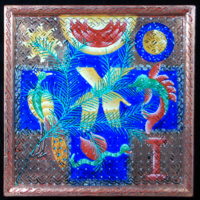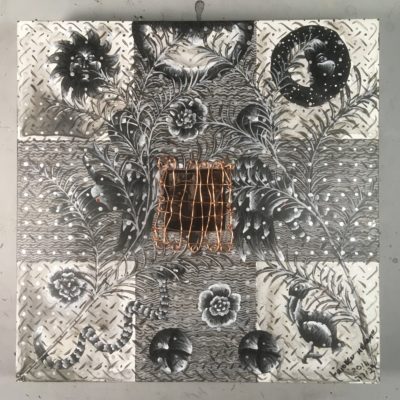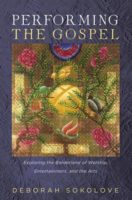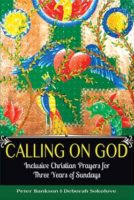 Deborah Sokolove is an artist, author, and liturgist. Her paintings combine elements from the icon tradition of the Eastern branches of Christianity; the elaborate knot work found in Celtic artifacts; the space-filling patterns of Islamic tiles; folk motifs from Latin America, Africa, and Asia; and contemporary notions about art. Her books are about the relationship between worship and the arts.
Deborah Sokolove is an artist, author, and liturgist. Her paintings combine elements from the icon tradition of the Eastern branches of Christianity; the elaborate knot work found in Celtic artifacts; the space-filling patterns of Islamic tiles; folk motifs from Latin America, Africa, and Asia; and contemporary notions about art. Her books are about the relationship between worship and the arts.
About the Paintings
 I grew up in Los Angeles, a city named after the Queen of the Angels. There, the echoes of Latino Catholicism permeate even the most resolutely Protestant, as well as non-Christian, neighborhoods. As part of their historical education, California school-children of all faiths are taken to visit the mission churches founded by Franciscan brothers, and learn local geography as a kind of litany of saints’ names. As a child, I was profoundly affected by both the visual and the spiritual texture of the mission churches I had visited. The side walls, the massive ceiling beams, and especially the reredos behind the altars, were filled with painted and carved patterns; the statues and sacred images were clothed in lace and filigree. Although now I think also of the problematic nature of conquest and colonization, my earliest memories of these places are of the aura of prayer that infuses them.
Years later, in Israel, I visited mosques whose walls were covered with ornate calligraphies and decorative motifs. There, I experienced the same sense of peace, mystery, and the presence of God. Likewise, in the gothic cathedrals of Europe, and in the illuminated books created in medieval monasteries, the same love of ornament spoke to me of the extravagance of creation. The rich mosaics, paintings, jewels, and precious metals that adorn many places of worship are intended to make those who enter feel as though they were already in heaven, if only for a brief moment.
In my own work, I am attempting to evoke this sense of eternity, of the divine presence, that I find in these traditional artforms, as well as in the gleam of flickering candles, or in a night sky filled with stars. As an analogue to my belief that every time and place participates in God’s self-revelation, I combine elements from the icon tradition of the Eastern branches of Christianity; the elaborate knot work found in Celtic artifacts; the space-filling patterns of Islamic tiles; folk motifs from Latin America, Africa, and Asia; and contemporary notions about art. The resulting paintings are intended as an offering into the life of the Body of Christ, my own prayers made visible as an invitation to others.
I grew up in Los Angeles, a city named after the Queen of the Angels. There, the echoes of Latino Catholicism permeate even the most resolutely Protestant, as well as non-Christian, neighborhoods. As part of their historical education, California school-children of all faiths are taken to visit the mission churches founded by Franciscan brothers, and learn local geography as a kind of litany of saints’ names. As a child, I was profoundly affected by both the visual and the spiritual texture of the mission churches I had visited. The side walls, the massive ceiling beams, and especially the reredos behind the altars, were filled with painted and carved patterns; the statues and sacred images were clothed in lace and filigree. Although now I think also of the problematic nature of conquest and colonization, my earliest memories of these places are of the aura of prayer that infuses them.
Years later, in Israel, I visited mosques whose walls were covered with ornate calligraphies and decorative motifs. There, I experienced the same sense of peace, mystery, and the presence of God. Likewise, in the gothic cathedrals of Europe, and in the illuminated books created in medieval monasteries, the same love of ornament spoke to me of the extravagance of creation. The rich mosaics, paintings, jewels, and precious metals that adorn many places of worship are intended to make those who enter feel as though they were already in heaven, if only for a brief moment.
In my own work, I am attempting to evoke this sense of eternity, of the divine presence, that I find in these traditional artforms, as well as in the gleam of flickering candles, or in a night sky filled with stars. As an analogue to my belief that every time and place participates in God’s self-revelation, I combine elements from the icon tradition of the Eastern branches of Christianity; the elaborate knot work found in Celtic artifacts; the space-filling patterns of Islamic tiles; folk motifs from Latin America, Africa, and Asia; and contemporary notions about art. The resulting paintings are intended as an offering into the life of the Body of Christ, my own prayers made visible as an invitation to others.
Books
 Sanctifying Art:
Inviting Conversation between Artists, Theologians, and the Church
Sanctifying Art:
Inviting Conversation between Artists, Theologians, and the Church
As an artist, I have often been surprised and dismayed by the unexamined attitudes and assumptions that the church holds about how artists think and how art functions in human life. By investigating these attitudes and tying them to concrete examples, I hope to demystify art—to bring art down to earth, where theologians, pastors, and ordinary Christians can wrestle with its meanings, participate in its processes, and understand its uses. In showing the commonalities and distinctions among the various ways that artists themselves approach their work, Sanctifying Art can help the church talk about the arts in ways that artists will recognize. As a member of both the church and the art world, I want to bridge the gap between the habits of thought that inform the discourse of the art world and those quite different ideas about art that are taken for granted by many Christians. When art is understood as intellectual, technical, and physical as well as ethereal, mysterious, and sacred, we will see it as an integral part of our life together in Christ, fully human and fully divine.
Sanctifying Art is availlable directly from the publisher here








 Performing the Gospel:
Exploring the Borderland of Worship, Entertainment, and the Arts
Performing the Gospel:
Exploring the Borderland of Worship, Entertainment, and the Arts Calling on God:
Inclusive Christian Prayers for Three Years of Sundays
Calling on God:
Inclusive Christian Prayers for Three Years of Sundays